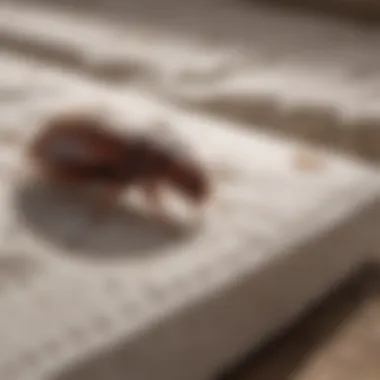Effective Strategies for Eliminating Bedroom Bugs


Intro
Bugs in the bedroom can pose a significant challenge to comfort and hygiene. Understanding how to deal with these pests effectively is crucial for maintaining a peaceful sleeping environment. In this guide, we will explore strategies for identifying common bedroom bugs, as well as effective methods for prevention and elimination. Awareness of these strategies can help you reclaim your space while ensuring a healthier atmosphere.
Design Inspirations
Trending Styles
A clean and organized bedroom helps in reducing the chances of bugs taking up residence. Applying minimalistic designs with less clutter can be beneficial. Simple furniture arrangements can enhance the flow of movement, making it easier to spot and eliminate pests.
Color Palettes
Light and neutral color palettes can create an inviting atmosphere. Opt for shades like soft beige or pastel tones. These colors not only provide a sense of calm but also allow for easier detection of bugs against the lighter backgrounds.
Identifying Common Bedroom Bugs
Recognizing the types of pests in your bedroom is critical to targeted elimination strategies. Some common culprits include:
- Bed Bugs: Small, brownish insects that hide in the seams of mattresses and bed frames.
- Dust Mites: Microscopic pests that thrive in bedding and upholstery.
- Ants: They can enter through small cracks looking for food or moisture.
- Fleas: Typically found if you have pets, they can quickly infest bedding.
Understanding their habits and habitat allows for more effective treatment and prevention.
Preventive Measures
To prevent bugs from invading your bedroom, consider the following actions:
- Regular Cleaning: Vacuuming carpets, upholstery, and under the bed can significantly reduce pest populations.
- Seal Cracks: Ensure that any gaps in windows, doors, or walls are properly sealed to prevent entry.
- Bedding Maintenance: Wash sheets and pillowcases in hot water regularly to kill dust mites and bed bugs.
- Reduce Clutter: Keeping your space tidy minimizes hiding spots for pests.
Treatment Options
When dealing with an infestation, you have various treatment options, both organic and chemical:
- Organic Solutions: These include diatomaceous earth or essential oils such as tea tree or lavender.
- Chemical Treatments: Products like Raid and Ortho can be effective but must be used cautiously, especially in living spaces.
Always follow instructions carefully to ensure safety.
"Identifying the type of bug is the first step in effectively dealing with infestations."
Best Practices for Maintenance
Maintaining a bug-free environment requires diligence. Here are some strategies:
- Routine Inspections: Regularly check mattresses and furniture for signs of bugs.
- Control Humidity: Bug problems can escalate in high humidity. Use a dehumidifier if necessary.
- Pest Control Professionals: Consider scheduling periodic inspections and treatments by professionals for persistent issues.
Product Recommendations
Bath Accessories
Investing in quality bath accessories can improve cleanliness. Use a waterproof trash can and washable bathroom mats for easy maintenance.
Bedroom Essentials
Select bedroom essentials such as hypoallergenic pillows and mattress covers. These products can reduce allergens and pests.
Understanding the Problem
Recognizing the presence of bugs in your bedroom is more than a matter of discomfort. Bugs can pose significant health risks and disrupt one’s peace of mind. Understanding the problem begins with acknowledging the types of pests that can invade this personal space, as well as the implications these pests can have. Often, bed bugs, fleas, and other insects are not just nuisances; they can lead to allergic reactions, infection, and in some cases, chronic conditions.


A thorough understanding of this issue empowers individuals to take informed actions. Preventive strategies play a crucial role here. Knowing what bugs are likely to invade your bedroom can help you take measures to prevent their entry and establish a comfortable, relaxing environment. Thus, becoming well-informed about the characteristics and behaviors of these pests sets the groundwork for the entire article.
This knowledge cultivates not only awareness but also the motivation to act. Homeowners who understand the dynamics of bedroom infestations are better equipped to spot issues early and implement effective solutions. In essence, this section serves as the foundation for developing a bug-free bedroom, enhancing both safety and comfort.
Preventive Measures
Preventive measures are crucial in maintaining a bug-free bedroom. They not only minimize the risk of infestations but also contribute to a healthier living environment. By implementing effective strategies, you can reduce the likelihood of bugs finding a way into your personal space. Regularly practicing these measures can result in long-term benefits, including reduced stress and enhanced comfort in your home.
Maintaining Cleanliness
Regular Cleaning Routine
A regular cleaning routine is fundamental in keeping bedroom bugs at bay. By establishing a consistent cleaning schedule, you minimize the accumulation of dust and debris, which can attract pests. Regular vacuuming, dusting, and mopping can disrupt potential infestations early on.
The key characteristic of a regular cleaning routine is its ability to create a hygienic environment. This helps eliminate food sources for bugs and discourages them from settling in. It's a beneficial approach because it does not require special products or treatments. Instead, it relies on diligent maintenance.
One unique feature of regular cleaning is the ability to spot signs of infestation early. While cleaning, you may notice unusual spots or droppings. This can lead to quicker responses, preventing a more severe infestation later. However, the disadvantage might be the time commitment involved. It requires dedication over time to see significant results.
Decluttering Strategies
Decluttering strategies are essential in the fight against bedroom bugs. Keeping your space organized not only promotes a pleasing aesthetic but also reduces hiding spots for pests. Limiting clutter allows you to monitor your space more closely, making detection easier.
The key characteristic of decluttering is its impact on managing physical space. By reducing excess items, you limit areas where bugs can hide. This is a popular choice since it simplifies the cleaning process, making it quicker and more efficient.
One unique feature of decluttering is its dual benefit: it enhances your living environment and minimizes pest-related issues. While decluttering can initially seem overwhelming, the long-term advantage of a more manageable space can outweigh this initial burden. However, it requires ongoing effort to maintain a clutter-free environment.
Sealing Entry Points
Inspecting Windows and Doors
Inspecting windows and doors is an effective preventive measure against bedroom bugs. Bugs often enter through these openings, so ensuring they are well-maintained is vital. Regular inspections allow you to identify any gaps or damages that insects can exploit.
The importance of this practice lies in its ability to block potential entry points. By being proactive in checking these areas, you can prevent issues before they escalate. It is a beneficial choice because you can often perform it yourself without the need for extensive tools or services.
A unique feature of inspecting your windows and doors is your ability to directly control your environment. Making small adjustments, like re-adjusting screens or repairing seals, can make a significant impact on your living space. However, it may also require time and willingness to acknowledge and address minor imperfections.
Using Caulking and Weather Stripping
Using caulking and weather stripping is another practical measure to seal entry points. Applying these materials prevents insects from coming in through gaps in your home’s exterior. It is an effective way to create tight seals around windows and doors.
The key characteristic of this method is its durability. Once applied, caulking and weather stripping can significantly reduce the likelihood of bugs entering for an extended period. This makes it a popular choice for homeowners seeking reliable solutions.
The unique feature of using these materials is the long-lasting protection they can provide. This reduces the need for frequent inspections and repairs. However, the disadvantage is that it requires proper application techniques to work effectively. Poor application can lead to ineffective barriers.
Choosing Bug-Resistant Materials
Fabric Choices for Bedding
Selecting the right fabric for bedding can influence your bedroom's pest resistance. Certain fabrics are less hospitable for bugs, reducing the risk of infestations. For example, natural fibers like cotton are breathable but can absorb moisture, which may attract some pests.
The key element of fabric choice lies in understanding the properties of different materials. Opting for tightly woven fabrics can inhibit bugs from nesting or hiding. This is a beneficial choice for those wanting an immediate upgrade to their bedding.
A unique aspect of fabric selection is the vast range of options. While there are benefits to choosing synthetic fabrics that resist pests, some may not be as comfortable. Being mindful of the trade-offs is crucial when making fabric decisions for your bedding.
Selecting Flooring Options
Selecting appropriate flooring options is a critical component of creating a bug-resistant environment. Hard surfaces like tile or hardwood can deter certain bugs, while carpets may provide a breeding ground for pests if not maintained properly.


The key characteristic of flooring choice is its long-term impact on your space. Hard surfaces can be easier to clean and less prone to harbor pests. This makes it a popular selection among homeowners who prioritize hygiene.
A unique feature of flooring selection is that it can fundamentally change the dynamics of your bedroom environment. While softer carpets can add comfort, they require more diligent cleaning to prevent bug issues. Weighing the advantages and disadvantages of each option is essential in making informed decisions.
Identifying Effective Treatment Options
Identifying effective treatment options is a crucial step in addressing the presence of bugs in your bedroom. This section aims to explore various methods tailored to your specific needs. Recognizing the right treatment approach is vital as different types of infestations may require distinct solutions. Effective treatment helps not only in eradicating pests but also in preventing future infestations, ensuring long-lasting comfort in your living space.
Organic Pest Control Methods
Essential Oils
Essential oils are an integral part of organic pest control. They are derived from plants and have natural insect-repelling properties. Common choices include lavender, tea tree, and eucalyptus oils. These oils are popular for their pleasant fragrances and their ability to ward off various insects. A key characteristic of essential oils is their safety for indoor use, making them suitable for households with pets and children. Their unique feature is that they can be easily applied through diffusion or mixed with water for sprays. Advantages include their non-toxic nature and additional health benefits, such as improving air quality. However, it's important to note that while essential oils can repel bugs, they may not completely eliminate a strong infestation.
Natural Repellents
Natural repellents come in various forms and typically use ingredients that are less harmful to the environment. Common natural repellents include diatomaceous earth and vinegar solutions. The key characteristic of natural repellents lies in their eco-friendly composition, appealing to those who prefer sustainable solutions. They are favored in this article for their accessibility; many can be made at home with simple ingredients. A unique feature is their dual functionality, as some also aid in cleaning surfaces. The advantages of natural repellents include being easy to find and create. Their disadvantage, however, is that they often require consistent application to remain effective, particularly in the presence of heavy infestations.
Chemical Treatment Solutions
Insecticides Explained
Insecticides are chemical agents specifically designed to kill or control insect populations. They are a more aggressive approach compared to organic methods and can achieve quicker results. The key characteristic of insecticides is their targeted action against specific bugs, making them effective for severe infestations. This article emphasizes insecticides as a beneficial option because they often penetrate hard-to-reach areas where bugs hide. A unique feature is the variety of formulations available, including sprays, powders, and baits. Insecticides offer significant advantages, such as rapid elimination of pests. The downside includes potential health risks for humans and pets, necessitating careful handling and application.
Application Techniques
Application techniques are critical for ensuring that chemical treatments are effective. It involves knowing the correct dosage and method of application depending on the product used. The main characteristic of proper application techniques is their influence on treatment success. This article discusses effective techniques because incorrect application can lead to inadequate control. A unique aspect is the use of protective gear during application to minimize health risks. Advantages of proper techniques include enhanced effectiveness and increased safety. However, a disadvantage may be a steeper learning curve for some users, particularly those unfamiliar with pest control products.
Professional Pest Control Services
What to Expect
Engaging professional pest control services provides peace of mind and expertise in tackling bug infestations. Understanding what to expect from these services is crucial. These professionals will conduct thorough inspections and determine the most effective treatment plans tailored to your specific situation. The key characteristic of professional services is their comprehensive approach. This article highlights their benefits, as they can address complex infestations that DIY methods may struggle with. A unique feature is their ability to follow up with inspections and additional treatments if necessary. Advantages include guaranteed results and expert guidance. The disadvantage can be the cost involved, making it a significant consideration for homeowners.
Evaluating Service Providers
Choosing the right pest control provider is essential for effective treatment. Evaluating service providers requires looking at factors like reputation, methods used, and customer feedback. The key characteristic of evaluation is the scrutiny of service quality and effectiveness. This article emphasizes the importance of this process as not all companies are created equal. Unique features to assess include certification and insurance of the providers. The advantages of thorough evaluation include finding reliable support, leading to successful pest eradication. However, the disadvantage is that the process may take time, requiring research and comparison.
Effective pest control involves understanding various treatment options and recognizing the importance of tailored solutions.
Post-Treatment Maintenance
Post-treatment maintenance is essential in ensuring the long-term effectiveness of any pest control strategy. Once you have successfully eliminated bugs from your bedroom, it is crucial to implement measures that will prevent re-infestation. This involves consistent monitoring, effective cleaning routines, and a proactive approach to maintaining your living environment. The benefits of having a post-treatment maintenance plan include reducing the likelihood of bugs returning, improving overall hygiene, and enhancing your personal comfort within the space.
Monitoring for Recurrences
Establishing a Checklist
Creating a comprehensive checklist is a strategic way to monitor for any signs of bug return. A checklist helps in systematically assessing different areas of your bedroom regularly. Its key characteristic is its simplicity and ease of use. By writing down specific tasks such as inspecting corners, mattresses, and under the bed, you develop a routine that enables you to catch potential problems early. This is a beneficial practice because it encourages focused attention on areas most affected by bugs, which can lead to quicker identification of any issues.
The unique feature of using a checklist is its capacity to ensure that no area gets overlooked. Moreover, having a documented approach can be motivating, as it allows you to mark off completed tasks. However, one disadvantage could be that strict adherence to a checklist may lead to complacency if done mechanically without actual visual inspections.
Setting Regular Check-Ins
Setting regular check-ins is another effective strategy in post-treatment maintenance. This involves scheduling specific times to evaluate your bedroom for any signs of bug activity. The key characteristic of regular check-ins is that they contribute to establishing a consistent schedule that aids in early detection of infestations.
This method is beneficial because it creates accountability. By having set times to check, you cultivate a habit that prioritizes your living space's hygiene. Additionally, regular check-ins help keep the focus on maintaining a bug-free environment, reducing the chances of an infestation developing unnoticed. However, one potential disadvantage is that if check-ins are too infrequent, you might miss early warning signs.


Continuing Effective Cleaning Practices
Upholding a Cleaning Schedule
Upholding a cleaning schedule is vital for maintaining cleanliness after the initial treatment for bugs. A cleaning schedule provides structure and ensures that your cleaning efforts are not sporadic but systematic. Its key characteristic is that it helps to establish a routine that can significantly decrease the chances of pests returning.
This choice is beneficial because regular cleaning reduces crumbs and clutter, which attract bugs. Additionally, a consistent schedule helps to instill discipline in maintaining your space. The unique aspect of a cleaning schedule is that it can be tailored to fit your lifestyle. If planned correctly, it can integrate seamlessly into your daily or weekly routine, making it sustainable. However, a possible downside is the need for commitment; without proper adherence, the process can easily fall off track.
Deep Cleaning Techniques
Incorporating deep cleaning techniques is essential for addressing areas that regular cleaning may miss. Deep cleaning goes beyond surface-level tidying and focuses on getting into the nooks and crannies of the room. Its main characteristic is its thoroughness, making it a powerful tool in your bug elimination arsenal.
This approach is beneficial as it targets potential hiding spots for bugs, such as behind furniture and beneath carpets. Adopting deep cleaning techniques can greatly enhance the likelihood of spotting early signs of an infestation. However, its unique feature is the time investment it requires. Deep cleaning can be labor-intensive and might need to be done less frequently than regular cleaning. On the downside, it is still essential to prioritize even these less frequent clean-ups to maximize your defense against pests.
Maintaining vigilance and proactive cleaning techniques is critical for a bug-free bedroom.
Creating a Bug-Resistant Environment
A bug-resistant environment is crucial for maintaining comfort and hygiene in your bedroom. Insect pests can not only disrupt your peace but also pose potential health risks. Creating an environment that deters these pests is beneficial for long-term relaxation and safety. This section will address specific elements that contribute to actively preventing bugs from making your bedroom their home.
Choosing Insect-Repelling Plants
Optimal Plant Choices
Insect-repelling plants serve as a natural barrier against various pests. Some notable examples include lavender, mint, and rosemary. These plants contain oils and compounds that insects find unappealing. Their aromatic qualities not only enhance the aesthetics of your bedroom but also contribute to a serene atmosphere. Choosing optimal plant options can improve air quality as well. However, not all plants thrive indoors. It's critical to pick varieties that flourish in low light and regulated humidity, ensuring longevity and effectiveness in pest control.
Placement Considerations
The placement of insect-repelling plants is as vital as their selection. Strategic positioning enhances their effectiveness. Placing plants near windows and entry points can create a natural deterrent. Additionally, positioning them on nightstands or shelves allows for easy management. Some plants might demand more sunlight than others. Therefore, understanding each plant’s needs is essential in maintaining a healthy indoor garden. Proper placement not only promotes pest control but can also elevate your room's decor.
Enhancing Bedroom Layout for Prevention
Furniture Arrangement
The arrangement of furniture plays a significant role in deterring bugs. A clutter-free layout minimizes hiding places for pests. Ensure that there is adequate space between furniture and walls, making it harder for insects to find shelter. Additionally, avoid placing beds and sofas directly against walls. This can create unkempt gaps where bugs can thrive. Thus, furniture arrangement becomes an important aspect of a bug-resilient environment, ensuring every corner is visible and accessible for cleaning.
Storage Solutions
Efficient storage solutions are essential in keeping your bedroom organized. Opt for sealed storage bins and drawers that limit exposure and entry points for bugs. Clear plastic containers are particularly effective as they allow for quick visibility of the contents while still providing a barrier. Regularly decluttering is also vital; it reduces potential nesting sites and simply makes it harder for insects to adapt to their surroundings. By implementing smart storage practices, you can significantly decrease the likelihood of infestations.
Finale: Achieving Long-Term Relief
In achieving long-term relief from bedroom bugs, one must recognize this process is not simply a one-time event. It requires ongoing commitment and clear strategies to maintain a bug-free environment. As discussed throughout the article, various methods exist for both preventing and managing infestations. These initiatives are not just beneficial for hygiene but also essential for mental well-being. An effective bug management approach contributes to a more restful sleep and a heightened overall quality of life.
Summarizing Key Strategies
To underline the importance of this discussion, it is vital to revisit the core strategies for eliminating bugs in the bedroom. These strategies include:
- Preventive Measures: Keeping a clean space, sealing entry points, and choosing materials that are less attractive to pests.
- Effective Treatment Options: Understanding both organic methods, such as essential oils, and chemical treatments, including insecticides, based on individual preferences and needs.
- Post-Treatment Maintenance: Regularly monitoring the area and upholding effective cleaning practices.
- Creating a Bug-Resistant Environment: Implementing strategies such as utilizing insect-repelling plants and optimizing bedroom layouts.
By adhering to these guidelines, any household can significantly reduce the chances of encountering bedroom bugs.
Encouraging Ongoing Vigilance
Continuous vigilance is crucial in the battle against bedroom insects. For many, this might feel tedious. However, by integrating simple routines into daily life, the task becomes manageable.
Establish checklists and regular reminders for inspections. Train yourself to recognize patterns that may indicate re-infestation, such as unusual bites or signs of droppings.
Some practical ways to maintain awareness include:
- Regular Cleaning Schedule: Adhering to a consistent routine ensures that dust and debris, which can attract pests, are minimized.
- Establishing a Monitoring System: Check in on areas where bugs are likely to hide, including behind furniture or in crevices, routinely.
- Educating House Members: Share knowledge about identifying bugs and understanding their behavior to promote a unified approach to prevention.
Being proactive and informed will allow one to react swiftly to any signs of infestation, maintaining a comfortable and healthy bedroom environment.



